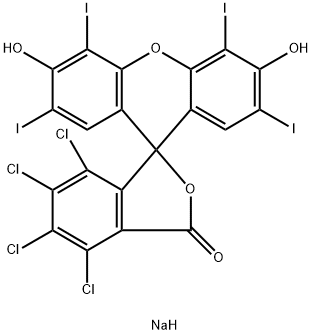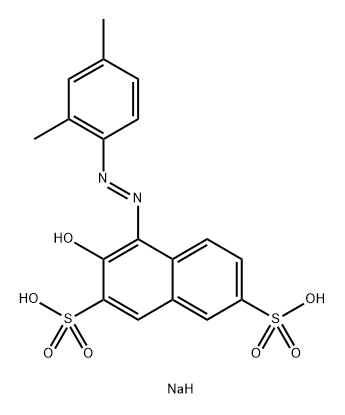Rose bengal , 90% , 632-69-9
Synonym(s):
Insulin-like growth factor I;Mechano growth factor;Somatomedin-C
CAS NO.:632-69-9
Empirical Formula: C20H5Cl4I4NaO5
Molecular Weight: 997.66
MDL number: MFCD00151169
EINECS: 211-183-3
| Pack Size | Price | Stock | Quantity |
| 5G | RMB111.20 | In Stock |
|
| 25G | RMB285.60 | In Stock |
|
| others | Enquire |
PRODUCT Properties
| Melting point: | >300°C |
| storage temp. | Store at +15°C to +30°C. |
| solubility | H2O: soluble1mg/mL |
| Colour Index | 45440 |
| form | Solid |
| pka | 3.9, 4.7(at 25℃) |
| color | Red-brown |
| Water Solubility | soluble |
| Sensitive | Light Sensitive |
| λmax | 548 nm |
| ε(extinction coefficient) | ≥90000 at 546-550nm at 0.008g/L |
| Merck | 14,8262 |
| BRN | 3645857 |
| Biological Applications | Apoptosis assay; diagnosis of diseases related to amyloid accumulation; controlling plant diseases; identifying fungi; treating skin,mouth,digestive tract,urinary tract,reproductive tract,respiratory tract,circulatory system |
| CAS DataBase Reference | 632-69-9(CAS DataBase Reference) |
| EPA Substance Registry System | Spiro[isobenzofuran-1(3H),9'-[9H]xanthen]-3-one, 4,5,6,7-tetrachloro-3',6'-dihydroxy-2',4',5',7'-tetraiodo-, disodium salt (632-69-9) |
Description and Uses
Rose bengal is a xanthene dye, fluorescein derivative, and photosensitizer. It exhibits absorption/emission maxima of 548/567 nm, respectively. Rose bengal binds to S. aureus cells and decreases survival of photoirradiated S. aureus to 0.012% when used at a concentration of 1 μM. It generates singlet oxygen when exposed to photoirradiation in cell-free assays and induces potassium ion leakage from S. aureus and bovine erythrocytes in the presence of photoirradiation. Rose bengal inhibits the cytochrome P450 (CYP) isoform CYP3A4/5 and the UDP-glucuronosyltransferase (UGT) isoform UGT1A6 in human liver microsomes in a light-dependent manner, with IC50 values of 0.072 and 0.035 μM, respectively, in yellow light, 3.1 and 4.2 μM, respectively, in ambient light, and 3 and 4.2 μM, respectively, in the dark. It has been used for staining of live cells, but exhibits both intrinsic and phototoxicity.
For research use only. Not for use in diagnostic procedures.
Please refer to the attached Protocolfor details.





